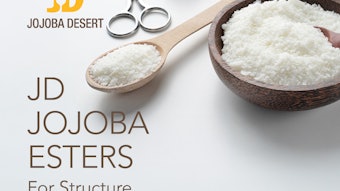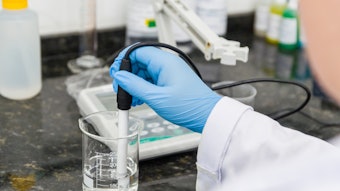Driven by market demands for products that eschew well-established yet controversial preservatives, such as parabens and formaldehyde donors, and faced with a dwindling number of economical alternatives for safe and effective preservation, formulators are increasingly turning to organic acids to protect products from microbial contamination.1 Among these organic acids, benzoic acid (BA) is a leading choice due to its long and successful history of use preserving foods, drugs and cosmetics.2 Affirmed as GRAS (Generally Recognized As Safe) by the US Food & Drug Administration (FDA), BA and its sodium salt, sodium benzoate (NaB), are perhaps the most globally acceptable preservatives that have managed to avoid the controversy associated with many of the industry’s tried-and-true preservatives.3–5
Chemistry and Manufacture
BA, shown in Figure 1, is the simplest aromatic organic acid, comprising a phenyl ring substituted with a single carboxylic acid group. Its molecular formula is C7H6O2 corresponding to a molecular weight of 122.12 g/mol.6, 7 The compound occurs naturally at levels ranging from 10–1000 ppm in a wide variety of fruits and berries, beer, wine, coffee, black tea and cultured dairy products, such as cheese and yogurt.2 The highest concentrations of naturally occurring BA are found in gum benzoin, a resinous material isolated from trees of the genus Styrax, which may contain up to 20% BA.7 Although BA isolated from natural sources is commercially available,8 it can cost over an order of magnitude more than synthetic BA, making it impractical (and most likely unsustainable) for most commercial applications.
The most widely employed process for commercial-scale synthesis of BA is the catalytic oxidation of toluene, a petroleum-derived aromatic hydrocarbon.7, 9 Figure 2 depicts typical reaction conditions employed in BA production. In this continuous process, air is bubbled through pressurized liquid toluene at elevated temperatures in the presence of a homogeneous oxidation catalyst based on cobalt and/or manganese metals.10, 11 The reactor yields a mixture of BA, toluene and other reaction by-products, including formic acid, acetic acid, benzene, benzaldehyde, benzyl alcohol, benzyl esters, biphenyl, methylbiphenyls and phthalic acid. This mixture is separated by distillation to isolate the BA and any useful by-products, e.g., benzaldehyde and benzyl alcohol, while the unreacted toluene is recycled back into the reactor. The crude BA is purified by either further distillation or extraction and crystallization to yield technical-grade BA. To obtain the high-purity compendial grades of BA, e.g., United States Pharmacopeia/Food Chemicals Codex (USP/FCC)-grade, the compound is recrystallized either from the melt or from solutions in toluene, water or methanol.
NaB (Figure 1) is produced via the neutralization of BA with aqueous solutions of caustic soda (sodium hydroxide) or soda ash (sodium carbonate). The NaB solutions are treated to remove trace impurities and color and then dried, compacted and milled to yield crystalline NaB in either powder or granular forms.
Properties
BA is typically supplied as a white crystalline solid, in either flake or powder form, with a melting point of 121–123° C.7, 12 It is a weak acid with a pKa value of 4.19. BA is lipophilic and sparingly soluble in water (solubility at 25° C = 0.34 g BA/100 g H2O), but dissolves readily in a wide range of organic solvents, such as ethanol and acetone. In contrast, NaB is readily water-soluble and can form concentrated aqueous solutions (solubility at 25° C = 61.2 g NaB/100 g H2O).7
Although the toluene oxidation process yields a number of organic by-products previously mentioned, these impurities are removed upon purification to technical-grade BA, which is typically >99.5% pure BA on an anhydrous basis.7 The USP/FCC-grade of BA employed in food, drug and cosmetic applications is also >99.5% pure, yet it has more stringent specifications; for example, it may not contain more than 10 ppm of trace heavy metals nor more than 0.7% water.12 The National Formulary (NF)/FCC-grade of NaB is also highly pure (>99.0%) and may not contain more than 0.04% residual alkalinity (as sodium hydroxide) nor more than 1.5% water.13
Technology and Applications
As stated earlier, BA and NaB are GRAS food preservatives in the United States and are permitted for use in food products up to a maximum concentration of 0.1%.3, 4 In cosmetic and personal care formulations, BA functions principally as a preservative, yet it has also been reported to function as a pH adjuster and a fragrance ingredient. NaB also functions as a preservative and fragrance ingredient, as well as a corrosion inhibitor.7, 14 The Cosmetic Ingredient Review Expert Panel considers BA and NaB safe for use in cosmetics up to a maximum concentration of 5%.15
The most critical aspect of BA and other organic acid preservatives is that they only possess efficacy when present in their acid form, i.e., when they are protonated.2, 5, 7 While BA demonstrates antimicrobial efficacy at relatively low concentrations (0.05–0.1%), NaB shows virtually no activity, even at high concentrations. Because NaB dissolves in water more easily than BA, it is usually added to the aqueous phase of formulations instead of BA to ensure rapid dissolution and uniform distribution of the preservative. Once the NaB is fully dissolved, the formula pH is then lowered, e.g., by the addition of citric acid, to protonate the salt and generate the active BA preservative.
Figure 3 shows the percentage of BA in its acid form as a function of solution pH, demonstrating the sharp decline in BA activity with increasing pH, especially in the region of the pKa (4.19). Thus, formulas relying on NaB as a preservative must be formulated to pH values sufficiently low enough to ensure that an adequate level of BA is present in the acid form. For example, a formula preserved with 1.00% w/w NaB will only contain 0.14% w/w active BA at pH 5.0. Attempting to formulate to pH values in excess of 5.0 is not practical, as it requires the addition of excessive amounts of NaB to ensure that enough active BA will be present. Additionally, products relying on BA for preservation should be buffered to maintain low pH values for the shelf life of the product to ensure that the BA will remain active.
Several theories have been proposed to explain the antimicrobial activity of BA and its underlying mechanism(s) of action.2 The ability of lipophilic organic acids, such as BA, to inhibit or kill microorganisms has been attributed to actions that include: interference with the permeability of the microbial cell membrane, leading to disruption of substrate transport and redox processes; reduction of intracellular pH; inhibition of amino acid uptake; and inhibition of specific enzymes. Given the diversity of biochemistry among microorganisms, it is likely that BA’s exact mechanism of action is highly dependent upon the specific microorganism in question.
Because BA is less potent against bacteria than it is against fungi, it is most effective as a preservative in products with relatively acidic pH values, i.e., pH <5.0, which present an additional hurdle for bacterial growth.2, 16 In a low pH environment, many species of bacteria will experience metabolic stress as they struggle to maintain intracellular pH, and thus their growth will be inhibited. To enable a broader spectrum of preservative efficacy with improved antibacterial performance, preservative blends have been developed that incorporate BA in conjunction with one or more additional preservative ingredients, such as phenoxyethanol, dehydroacetic acid or gluconolactone.17–19 These blends take advantage of BA’s exceptional antifungal activity and rely on the accompanying compounds for improved action against bacteria. When using these preservative blends, it is still critical to maintain an acidic pH in the formula to maximize the level of BA in the active acid form. The preservative efficacy should always be verified using the appropriate microbiological testing protocols.
In addition to its role as a preservative, BA is also an important starting material for the synthesis of benzoate esters that are used in cosmetics and OTC drugs as emollients, fragrance ingredients and solvents for hydrophobic actives, such as sunscreen agents. Notable examples include the emollients C12–15 alkyl benzoate and stearyl benzoate, and the fragrance ingredient benzyl benzoate. BA is also used to synthesize benzoyl chloride, the key starting material for benzoyl peroxide, one of the most well-known anti-acne agents.
References
1. T Branna, A Matter of Self-Preservation, HAPPI, Published online at www.happi.com/articles/2011/05/a-matter-of-selfpreservation (May 2011) (Accessed Sep 20, 2011
) 2. JR Chipley, Sodium Benzoate and Benzoic Acid, Chap 2 in Antimicrobials In Food, 3rd edn, CRC Press, Boca Raton, FL, USA (2005) pp 11–48
3. Code of Federal Regulations, 21 CFR 184.1021, Substances added directly to human food affirmed as generally recognized as safe (GRAS), Benzoic Acid
4. Code of Federal Regulations, 21 CFR 184.1733, Substances added directly to human food affirmed as generally recognized as safe (GRAS), Sodium Benzoate
5. DA Steinberg, Preservatives for Cosmetics, Allured Publishing Corp., Carol Stream, IL, USA (2006)
6. Benzoic Acid, Monograph ID 268, In the International Cosmetic Ingredient Dictionary and Handbook, 13th edn, Personal Care Products Council, Washington, DC, USA (2010)
7. JL Opgrande, EE Brown, M Hesser, J Andrews, Benzoic Acid, in Kirk-Othmer Encyclopedia of Chemical Technology, Vol 3, (online) John Wiley & Sons (May 16, 2003) pp 625–637
8. Benzoic acid, natural, >99.5%, FCC (Aldrich), Sigma-Aldrich Catalog No. W213128, www.sigmaaldrich.com/catalog/ (Accessed on Sep 20, 2011)
9. HA Wittcoff, BG Reuben, JS Plotkin, Chap 7, Chemicals and polymers from benzene, and Chap 8, Chemicals and polymers from toluene, in Industrial Organic Chemicals, John Wiley & Sons, Inc., Hoboken, NJ, USA (2004) pp 267–319
10. US Pat 3210416, Manufacture of benzoic acid from toluene, N Fragen and JG Hundley, assigned to Standard Oil Co. (Oct 5, 1965)
11. US Pat 3816523, Process for the production and purification of benzoic acid, H Sidi and M Sidey, assigned to Tenneco Chemicals Inc. (Jun 11, 1974)
12. Benzoic Acid, Official Monograph, In the United States Pharmacopeia 34–National Formulary 29, United Book Press Inc., Baltimore, USA (2011) p 2010
13. Sodium Benzoate, Official Monograph, In the United States Pharmacopeia 34–National Formulary 29, United Book Press Inc., Baltimore, USA (2011) pp 1660–1661
14. Sodium Benzoate, Monograph ID 2810, In the International Cosmetic Ingredient Dictionary and Handbook, 13th edn, Personal Care Products Council, Washington DC, USA (2010)
15. B Nair, Final report on the safety assessment of benzyl alcohol, benzoic acid, and sodium benzoate, Int J Toxicol, 20(Suppl 3) 23–50, (2001)
16. DS Orth, The keys to successful product preservation, Chap 2 in Insights into Cosmetic Microbiology, Allured Publishing Corp., Carol Stream, IL, USA (2006), pp 27–110
17. Geogard Ultra, Lonza Product Data Sheet, Lonza, Inc., Allendale, NJ, USA (Apr 27, 2011)
18. Euxyl K 701, Schülke Product Data Sheet, Schülke & Mayr GmbH, Norderstedt, Germany (Jan 26, 2011) 19. Euxyl K 702, Schülke Product Data Sheet, Schülke & Mayr GmbH, Norderstedt, Germany (Jan 26, 2011)










